
The Snake Oil Tycoon
The biggest conman of them all
Recently, I came across a tweet by a clinical psychologist named Dr. Jonathan Stea who claimed that the snake oil salesmen of the past never went away. He named wellness coaches, alternative practitioners, and energy medicine physicians as the modern day versions of these traveling conmen who provided “magical” elixirs that were promoted as “cure-alls” for disease. We’ve all seen these characters in many Western films. These were the seedy individuals who attempted to profit off of disease by selling “cures” that they knew were outright fraudulent. In many cases, the claimed “active ingredient” was nowhere to be found. Even worse, in some instances, harmful toxins such as lead, mercury, and arsenic were present, as seen in analysis of the “patent drugs” stored at the Henry Ford Museum collection. While mercury and arsenic are known toxins today, they were regularly billed as “cures” by medical men in the 19th and 20th century for many conditions including syphilis and leprosy. We have defintely seen examples of these same disingenuous tactics that were employed by the great medical showman of the late 19th and early 20th century being promoted by those claiming to treat disease today. Thus, is Dr. Stea correct in saying that these greedy hucksters throwing out “cure-alls” to the gullible are still around? And if so, are the professions that he listed truly the modern day incarnations of these travelling conmen?
While the “snake oil” term has been co-opted to refer to anyone who deceives others for money, primarily through the selling of fake “cures,” snake oil wasn’t always seen in such a controversial light. In the mid to late 1800s, many Chinese immigrants were brought over to work on the transcontinental railroads. These immigrants took with them various different remedies, including one made from the oil of the Chinese water snake. This oil is said to be rich in omega-3 acids, and it was used by the immigrants to help reduce inflammation and arthritis after long days of hard back-breaking labor on the railroad. This oil was said to be very effective, and the Chinese immigrants eventually shared their oil with Americans who were reportedly impressed by the positive effects:
A History Of ‘Snake Oil Salesmen’
“The 1800s saw thousands of Chinese workers arriving in the United States as indentured laborers to work on the Transcontinental Railroad. According to historian Richard White’s book Railroaded, about 180,000 Chinese immigrated to the United States between 1849 and 1882. The vast majority of the workers came from peasant families in southeastern China and were signed to contracts that ran up to five years for relatively low wages (compared with their white counterparts), wrote David Haward Bain in his book Empire Express.
Among the items the Chinese railroad workers brought with them to the States were various medicines — including snake oil. Made from the oil of the Chinese water snake, which is rich in the omega-3 acids that help reduce inflammation, snake oil in its original form really was effective, especially when used to treat arthritis and bursitis. The workers would rub the oil, used for centuries in China, on their joints after a long hard day at work. The story goes that the Chinese workers began sharing the oil with some American counterparts, who marveled at the effects.”
https://www.npr.org/sections/codeswitch/2013/08/26/215761377/a-history-of-snake-oil-salesmen
As per custom, the Americans saw an opportunity to capitalize on this idea of powerful ointments intended to cure many ailments. Over time, numerous products were created containimg ingredients such as alcohol, heroin, and cocaine that were sold by men traveling across the country. These included products such as Cocaine Toothache Drops for dental procedures, Mrs. Winslow Soothing Syrup made up of opiates to sooth crying babies, Jems made from strychnine to treat lack of focus and sexual dysfunction, Tapeworm eggs used as a weight loss remedy, and Morley’s Liver and Kidney Cordial, claimed to cure “all diseases of the liver, kidneys, stomach, and bowels, such as Liver Complaint, Biliousness, Malarial Diseases, Indigestion, Constipation, Kidney and Bladder troubles and all Diseases arising from Impure Blood and Deranged System.”
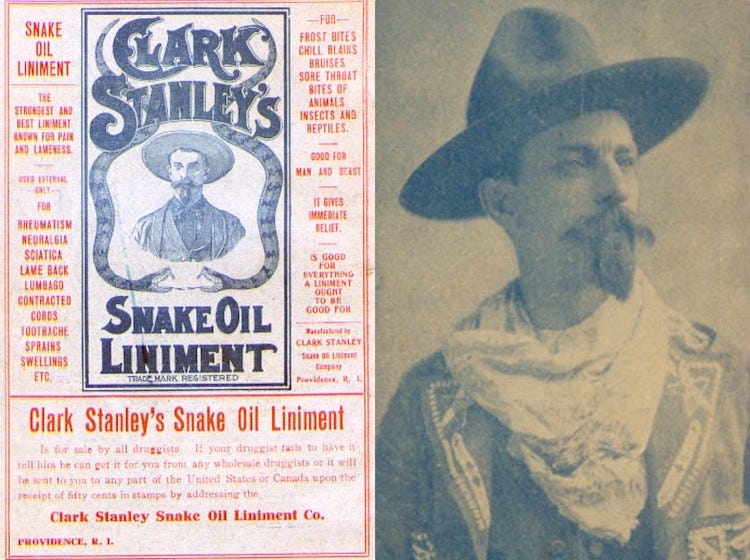
The most infamous case of snake oil fraud, and perhaps what ultimately led to this derogatory label being created from something with innocent roots, was that of Clark Stanley’s Snake Oil Liniment. This liniment was purportedly made from rattlesnake oil in order to capitalize on the goodwill of the Chinese oils. Rattlesnakes were settled upon as a replacement for the Chinese water snakes that were not available in the US. This oil was said to work for sciatica, rheumatoid arthritis, lame back, neuralgia, contracted muscles, toothaches, frostbite, swelling, etc. In an 1897 pamphlet titled The Life and Adventures of the American Cowboy, by Clark Stanley, Better Known as the Rattlesnake King, it is stated that Stanley learned of the formula for his remedy from his stay with the Hopi Indian tribe’s medicine men. Stanley, a self-proclaimed cowboy, had been bitten 100s of times by rattlesnakes, and always used a remedy. Apparently, the Hopi version was the best of the bunch supplying many proclaimed benefits, and this was what he said that he was selling to the public.
According to a 2008 article by Joe Schwarcz, the director of McGill University’s Office for Science and Society, Stanley was quite the showman. He would pluck out a rattlesnake from a sack, slit its throat, and then throw it in a pan of boiling water in front of a crowd of curious onlookers. Once the fat rose to the top, he would skim this off and use it to create and demonstrate the healing properties of his elixir. Stanley hyped up the crowd and used this excitement to sell his product.
“It must have been quite a sight at the World’s Exposition in Chicago in 1893. Clark Stanley, better known as The Rattlesnake King, reached into a sack, plucked out a snake, slit it open and plunged it into boiling water. When the fat rose to the top, he skimmed it off and used it on the spot to create “Stanley’s Snake Oil,” a liniment that was immediately snapped up by the throng that had gathered to watch the spectacle.
Little wonder. After all, Stanley had proclaimed that the liniment would cure rheumatism, neuralgia, sciatica, lumbago, sore throat, frostbite, even toothache.
It wasn’t too hard to convince the onlookers about the wonders of the liniment, particularly when it came to arthritis. All Stanley had to do was point out that snakes obviously did not suffer from this condition and seemed well lubricated internally. The crowd lapped up the hype and shelled out the money. And many claimed immediate relief from their pain.”
However, there was a glaring problem with Stanley’s rattlesnake oil. Upon a seizure of his product in 1917 as part of the Pure Food and Drug Act of 1906, chemical analysis by federal investigators apparently found that the product contained a mixture of mineral oil, beef fat, turpentine, camphor and red pepper — but not a single drop of rattlesnake oil. Due to his misleading of consumers by selling rattlesnake-less oil for over 24 years, Stanley was fined $20:
The story of Clark Stanley, the original snake oil salesman
“Oh, and Clark Stanley’s snake oil didn’t even contain snake. When federal regulators seized his product in 1917, they found it was a concoction of mineral oil, red pepper, turpentine, and cow fat. But by that point, he had already been selling the product for 24 years.
Clark Stanley’s trial for misbranding his product and “falsely and fraudulently represent[ing] it as a remedy for all pain” was a turn–of-the-century media circus, but in the end he was only charged $20 (about $429 in today’s dollars) for all the damage he had done.”
https://www.thequota.co/articles/the-story-of-clark-stanley-the-original-snake-oil-salesman
This episode shows that there is a long history of supposed medicines that promote healing effects containing ingredients that are not those listed as the star on the label. In some cases, opiates were sold which would have had an effect, but perhaps not in the way that was intended or as sold. In Stanley’s elixir, the snake oil was not present, but it did contain capsaicin from the red peppers which is a known anti-inflammatory agent. Despite the claim by federal investigators that Stanley’s oil did not contain any rattlesnake oil within it, the ingredients making up the elixir were considered to be all natural. The oil itself was said not to be toxic, and it was claimed to be helpful to many:
Snake Oil Salesman Shut Down by US Government
“Interestingly, though, although the snake oil that was examined had no actual snake oil in it, the red pepper and camphor that was there actually had a number of medicinal uses. Many of these medical uses correspond with Stanley’s claims. Today, a number of over-the-counter pain relievers use capsaicin as an active ingredient. Capsaicin is a natural remedy made from chili peppers. It works by inhibiting the pain receptors in the body.”
https://www.leadersinstitute.com/snake-oil-salesman-shut-us-government/
Stanley’s Oil was shut down after the federal investigation that was spurred by a 1906 act that looked at “preventing the manufacture, sale, or transportation of adulterated or misbranded or poisonous or deleterious foods, drugs, medicines, and liquors, and for regulating traffic therein, and for other purposes.” However, was Stanley’s elixir shut down solely due to the inaccurate label, or was he targeted as the fall guy by the emerging pharmaceutical empire that was being established at the time? Was the media frenzy during the Stanley incident an attempt to sway public perception in order to take out any competition? Were all of the snake oil salesmen really the charlatans that they were made out to be, or were they simply discredited and replaced by more successful and powerful conmen with greater financial and influential reach that wanted to corner the market and profit off of their compounds?
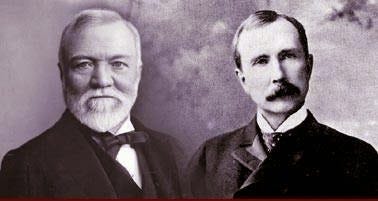
At the time that the federal government began shaking down and closing the businesses of those who were considered snake oil salesmen, there was a shuffling of the board taking place by powerful players with vested interests. A consolidation was occuring as the American Medical Association, established in 1847, began to claim ownership over those who were selling medicines and those who were considered healers in the late 19th and early 20th century. The AMA used its powerful advertising machine and long reach to discredit and wipe out the competition. The 1906 Pure Food and Drug Act was utilized as a crafty weapon to shut down those selling inaccurate or unlabeled medicines on the streets. The American College of Surgeons even adopted the entertaining tactics and showmanship of the snake oil salesmen in film and advertising campaigns in order to convince the public to turn to hospitals, places formerly known as “notorious death traps,” instead of seeking care from these products:
How snake oil got a bad name
Shifting fortunes
“What really sealed the fate of snake oil salespeople as the scammers and fraudsters we now take them to be, was not new information about the effectiveness of their wares, but rather the shifting fortunes of the medical marketplace. The 1906 Pure Food and Drug Act threw up new barriers to exactly the kind of unregulated interstate commerce that drove the medicine shows.
At the same time, professional medical organisations like the American Medical Association (AMA) began a powerful marketing campaign to discredit the competition, regardless of its ability to address and treat illness. Those who had been equal players in the 19th-century medical marketplace suddenly found themselves standing on the wrong side of history in the early 20th.
Given the contempt shown for the medicine show by groups like the AMA, it was somewhat ironic that another powerful medical association, the American College of Surgeons, adopted much the same format to hawk its own product: the standardised hospital. Sandwiching sermons of medical orthodoxy within a lineup of entertaining films, music and other exciting events, the college worked to convert the crowd from patent medicines to the care offered by their local hospital.
If the audience was sceptical and impatient for the show to go on, they had a right to be, since hospitals had long been notorious deathtraps. But both the familiarity of the format and the demonstrable improvements made to hospitals over this period made the travelling shows a raging success. Yesterday’s snake-oil sales tactics had become good medical practice.”
https://theconversation.com/how-snake-oil-got-a-bad-name-165574
The instigation of this push to consolidate and centralize the medical practices in America were spurred by two very wealthy and influential businessmen: Andrew Carnegie, who helped build the American steel industry, and John D. Rockefeller, the Standard Oil tycoon. In the early 1900s, the AMA decided to enlist the services of Andrew Carnegie, a man with no background in education, to recommend an overhaul of the medical educational practices. This led to the hiring of a young man named Abraham Flexner, brother of the director of the Rockefeller Institute Simon Flexner, to tour the over 155 medical schools that were around in the country at the time. Flexner, with no medical background and little expertise himself other than writing a few papers on education, was selected to visit each school very briefly. Afterwards, he wrote a report that was published in 1910, infamously known as “The Flexner Report,” that recommended the closing of more than one-half of these schools, many of which were homeopathic and alternative medicine practices based on ancient healing traditions. His report insisted on improving the conditions in all of the remaining schools. It called for a specific program and curricula to be adopted by all remaining, as well as any future, medical schools. Most importantly, it stipulated that all schools must undergo regular reviews in order for the renewal of their long-term accreditation following the initial approval by the AMA. In other words, in order to remain a medical school and to receive funding, all schools needed to adopt the new medical system that was built upon germ theory and the emergence of petrochemical medicines as a form of treatment. All alternative schools that did not wish to play ball were forced into closure. The AMA was given full control over what would be considered medicine as well as those who could practice it.
Flexner’s report delighted Carnegie and his board so much that Abraham was invited to do the same for Great Britain and the European continent. Neither Carnegie nor Abraham Flexner were physicians or those with a higher degree in education. However, they were allowed to reshape the medical landscape in America and abroad. Coincidentally (or not depending on how you look at it), Abraham Flexner was invited to join the General Education Board of the Rockefeller Foundation as a full-time member. In that position, he helped to oversee the remaining medical schools as well as the establishment of new ones. With the backing of the Rockefeller Foundations money, Flexner was able to open many new and influential medical schools throughout the country that are still running today:
Leadership in American Medicine as I See It: A Background in the Beginning
“The American Medical Association (AMA), founded in 1847 and incorporated in 1897, became concerned about the state of medical education and reached out to Andrew B. Carnegie with a request to study the problem of medical education and to make recommendations for how to correct this unsatisfactory state.”
“Carnegie and John D. Rockefeller, both highly interested and motivated industrial titans, recognized the vast importance of an outstanding medical education system and obtained the advice of educators throughout the country. Once Carnegie appreciated the drastic state of medical education, Dr Henry Pritchett, president of the Carnegie Foundation Board and a major leader in higher education as president of Yale University, responded to the AMA request on Carnegie’s behalf by agreeing to study the situation and recommend changes to American medical education. In a rather brief period of time, Pritchett and the Carnegie Foundation board selected a general educationalist, Abraham Flexner—a little known educator from Louisville, Kentucky, whose educational writings were already familiar to Pritchett—to conduct the study and make the necessary recommendations.”
“During these years, while managing his own high school, Abraham Flexner published extensively on higher education subjects in various education journals. These articles became well known by important leaders of higher education, including Dr Pritchett and other major educators such as Dr Charles W. Eliot, then president of Harvard University. Flexner’s writings in the general educational literature so impressed Pritchett, then serving as president of the board of the Carnegie Foundation, that he invited Abraham Flexner to meet the board, and the board subsequently invited him to participate in the AMA’s request to initiate a study of American medical school education. Supported by a small grant from the AMA to the Carnegie Foundation for income and expenses, Flexner personally visited each of the US schools of medicine. Most of his medical school visits were very brief. He interviewed the faculty (frequently only 1 physician) and visited the school’s laboratory (which not infrequently involved viewing a skeleton). At the conclusion of such visits, he had no doubts about recommending that the AMA close the school. During that 1 year’s time, Flexner recommended the closure of one-half of the medical schools in the country.
At the conclusion of his visits, Abraham Flexner wrote a detailed report that included his now-classic paper on American medical education. This report was published in 1910 in Bulletin No. 4 of the Carnegie Foundation for the Advancement of Teaching. Flexner’s world-shaking and revolutionary report dealt in detail with his recommendations on medical education, research, and clinical practice in the United States. In his report, Flexner insisted on the need to improve conditions in all of the existing institutions, and he called for specific programs and curricula in all of the remaining and future medical schools. He further insisted in his recommendations that every medical school must have a full-time medical faculty for both the preclinical and clinical subjects, and he required a close teaching relationship between the students and their faculty. He recommended that all medical schools include full-time teaching clinics for private as well as disadvantaged patients. He insisted on the absolute necessity for all schools of medicine to establish ongoing research programs. He also stipulated that all schools of medicine must undergo continuous periodic review for renewal of their long-term accreditation following their initial approval by the AMA.
As stated above, Abraham Flexner recommended that fewer than one-half of the existing medical schools remain active; all others were to be permanently closed. These findings and recommendations were so well received and accepted by Dr Pritchett’s Carnegie board and the AMA that Abraham Flexner was invited soon thereafter to review and offer recommendations on the state of medical education in Great Britain and, later, on the European continent.
Abraham Flexner’s recommendations thus began a new era of enlightened American medical education. The impetus for these cataclysmic changes must be attributed to the AMA’s recognition of the necessity to correct the existing state of medical education in the US, its request to a handful of forward-looking champions of academic excellence in American medical education, and implementation by the outstanding and committed board of directors of the Carnegie Foundation. This public-spirited American philanthropist, the concern of the AMA, and the remarkable consultative review and implementation by Abraham Flexner provided the necessary impetus to invigorate the conduct, practice, and growth of American medical academia that was so desperately necessary. It is truly remarkable to think that neither Andrew Carnegie nor Abraham Flexner was a physician or an individual with a higher degree in education. These outstanding leaders were characterized by their recognition that a critical medical educational problem existed, and both men were committed to correct that situation by using their respective resources during a remarkably brief time period.
Soon after the publication of his report, Abraham Flexner was invited to join the General Education Board of the Rockefeller Foundation as a full-time member. He remained on this governing board for many years until he retired to his own private educational consultative practice. However, during these long years Flexner provided the continuous overview of each American medical school and also recommended the establishment of new schools of medicine. Among his major recommendations was to establish new medical schools at the universities of Chicago, Rochester, and Vanderbilt. Flexner, through his personal knowledge and contacts, persuaded Julius Rosenwald, Nicholas Eastman, and Cornelius Vanderbilt to contribute major private donations to these institutions. These donations were supplemented by the Rockefeller Foundation with at least matched contributions to ensure the founding of these medical schools. These schools and a good number of others (including Johns Hopkins, Yale, Iowa, and Cincinnati) remain among the major medical institutions of this country.
https://www.ncbi.nlm.nih.gov/pmc/articles/PMC3527854/
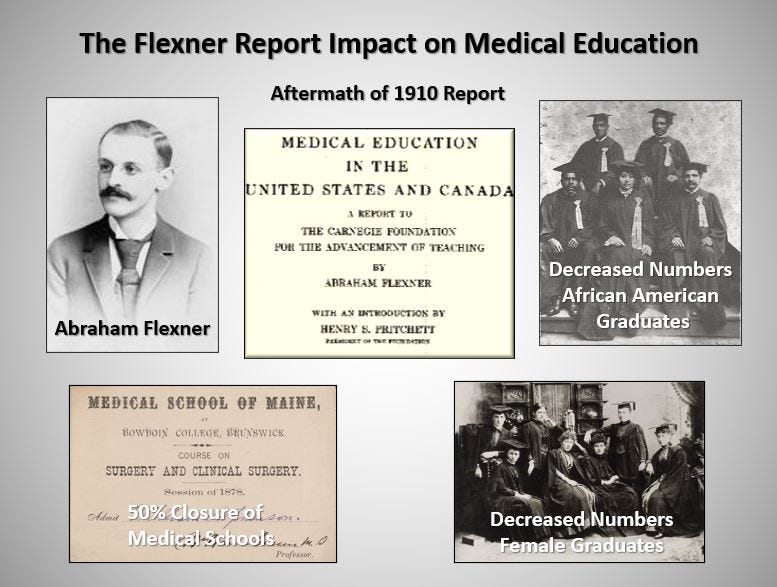
What should be very clear is that Abraham Flexner was a well-connected yet unqualified individual who was placed into a powerful position to do the bidding of the robber barons of the time, Andrew Carnegie and John D. Rockefeller. His report vilified and did away with many alternative schools that practiced chiropractic, naturopathy, homeopathy, holistic and herbal medicine. It allowed for the takeover of the modern medical system by those who were looking to peddle their petrochemical poisons that were created by the refinement of oils in order to sell them back onto the gullible public as “cures” for their ails. Flexner’s report created a culture that paved the way for the patenting and monetization of pharmaceuticals, allowing his bosses to profit handsomely from his work. This allowed for the practitioners of the allopathic model, consisting of the real snake oil-like practices of bloodletting, invasive surgery, and the injection of toxic heavy metals, to reframe themselves as “real medicine” in order to roll over the competition that mainly utilized natural ingredients that were now considered quackery:
How Rockefeller Created the Business of Western Medicine
“Certainly, Flexner’s report did have some valid points, but unfortunately the motives for the report were entirely driven my Rockefeller’s desire for complete control of the medical system. Based on the report, congress acted upon the Flexner’s recommendations and changed laws related to medical practice. Incredibly, allopathic medicine became the standard modality, even though at the time its main treatment methods where blood-letting, surgery (quite barbaric at the time) and the injection of toxic heavy metals (lead and mercury) to supposedly “displace disease”!
With new laws in place, Rockefeller teamed up with Andrew Carnegie and started funding medical schools all over America on the strict condition that they only taught allopathic medicine. Through the power of their huge “grants”, this powerful team systematically dismantled the previous curricula of these medical schools, removing any mention of the healing power of herbs or natural treatments. Teachings on diet and other natural (non-drug) treatments were also completely removed from medical programs.
After removing traditional medicine from medical schools, Rockefeller made sure to secure his monopoly by launching a targeted smear campaign against his competitors. Homeopathy and natural medicines were discredited and demonized through the newspapers and other media of the time. Some doctors were even jailed for using natural medicine treatments, including treatments that had been used safely and effectively for decades before. In a very short time, medical colleges were all homogenized. All the students were taught the same allopathic system and medicine was now defined as a process of prescribing patented drugs. “A pill for an ill” became the mindset of American medicine.”
https://meridianhealthclinic.com/how-rockefeller-created-the-business-of-western-medicine/
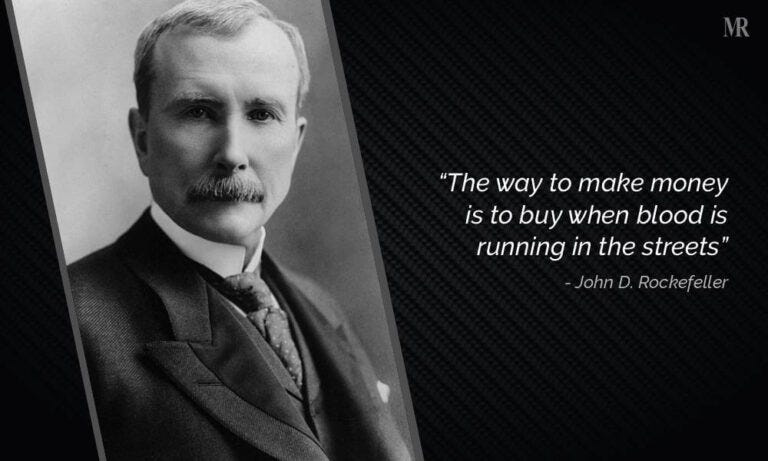
While Carnegie gets the credit for funding Flexner’s report, the major player in this takeover of the medical system was, in fact, John D. Rockefeller, who supplied the patsy brother of one of his leading researchers Simon, to do their bidding. Why was a successful oil tycoon so interested in the medical system and abolishing alternative medical practitioners as well as those selling elixirs in the streets? Even though John had become very wealthy with his oil monopoly, there were investigations and threats of breaking his organization apart, which was ultimately decided by the Supreme Court on May 5th, 1911, a year after the Flexner Report was published. Thus, Rockefeller needed another avenue to capitalize and make money off of his product. He came across the idea of utilizing coal tar in order to create products that affect the human body. Scientists in the early 1900s were discovering that they could create many chemicals from the oil, and eventually decided that these could be used to create pharmaceutical products. Fortunately for Rockefeller, the compounds made from petrochemicals could be patented, thus creating a very profitable market for him. In fact, 99% of the pharmaceutical products today contain petrochemicals, so it is clear that this was a market that was of vast interest to Rockefeller and his Standard Oil monopoly. With much of the country still believing in the healing traditions of the past, he needed to wipe away the competition in order to corner the market. How fortuitous for Rockefeller that the Pure Food and Drug Act of 1906, which wiped out the snake oil salesmen, and the 1910 Flexner Report that took care of the alternative medicinal practices, paved the way for him to monopolize the healthcare market with his oil, petrochemicals, and money. Rockefeller’s General Education Board, headed by Abraham Flexner, provided hundreds of millions of dollars to doctors and scientists in order to get them on board with the allopathic model. Huge grants were given to scientists to discover chemicals in plants that had certain effects, and then recreate them synthetically so that they were just different enough in order to be patented. Rockefeller, with the help of his friend Andrew Carnegie and the stooge Abraham Flexner, wiped out natural medicine and created a model where a patented synthetic pill would be available for every ill.
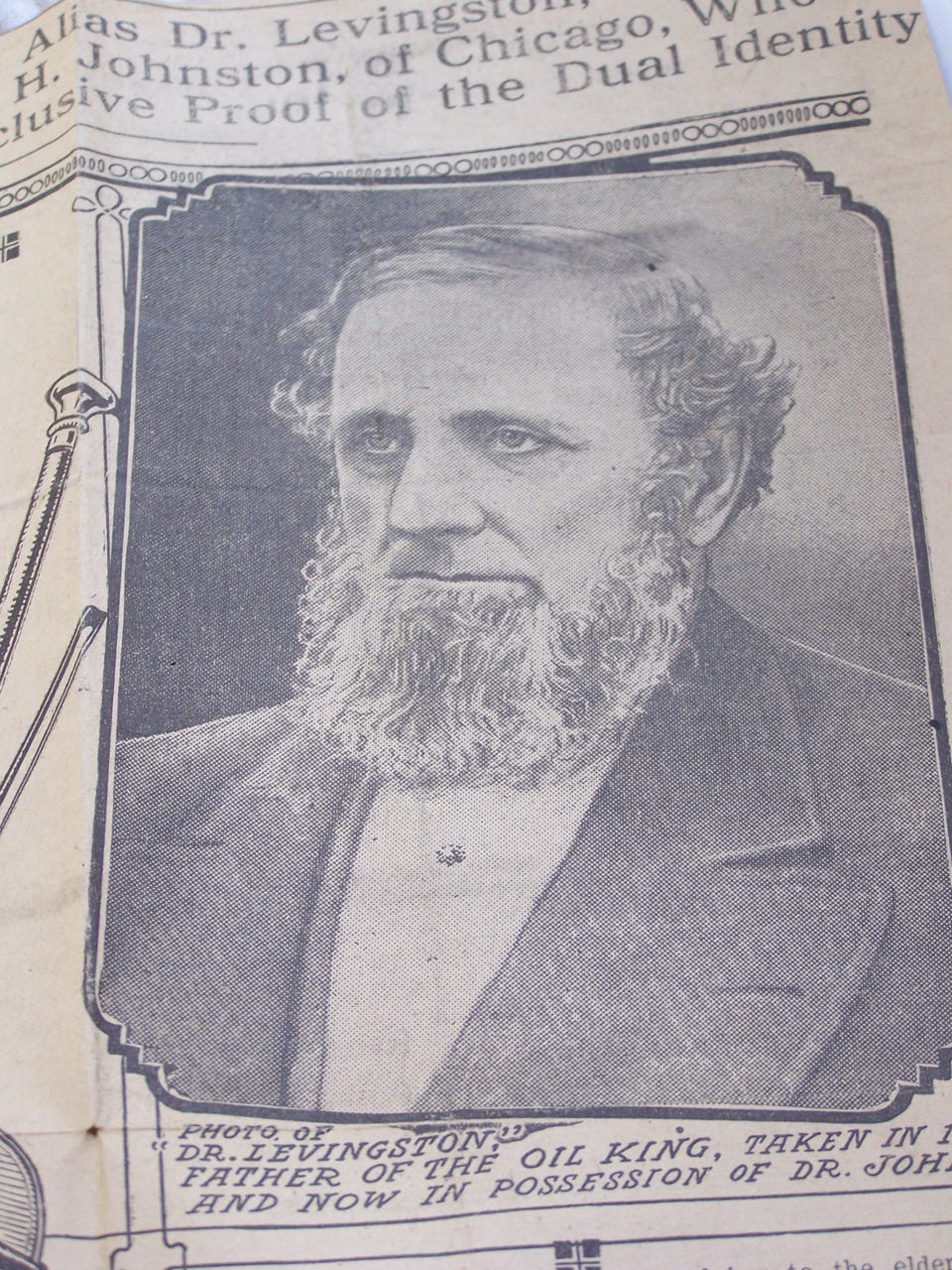
Another motivating factor for this takeover of the modern medical system by John D. Rockefeller was the direct influence of his very own father, William Rockefeller, who was, in fact, a traveling snake oil salesman. He even lived a double life as a physician by the name of William Levingston:
1. His father was a con artist and a bigamist.
“The tycoon’s father, William Avery Rockefeller, was a traveling snake-oil salesman who posed as a deaf-mute peddler and hawked miracle drugs and herbal remedies. The smooth-talking huckster dubbed “Devil Bill” alternately fathered children—including the future industrialist—with his wife and mistress, the couple’s live-in housekeeper. The itinerant William Rockefeller also lived a double life posing as an eye-and-ear specialist named Dr. William Levingston, and in 1855 he secretly married another woman.”
https://www.history.com/news/10-things-you-may-not-know-about-john-d-rockefeller
According to a 2019 article also published on History.com, William Rockefeller would place huge wads of cash that he refused to keep in a bank lovingly in front of his impressionable son. This money came from a slew of shady business ventures including “pretending to be a deaf and blind peddler to posing as a doctor to hawk patent medicines.” The elder Rockefeller, who was known by the moniker “Devil Bill,” was suspected of horse stealing and was even indicted for rape in 1849. William was a bigamist who lived a double life, posing as the physician William Levingston during the last decades of his life. According to his associates, William “had a big jug of medicine and [he] treated all diseases from the same jug.” William would “laugh about his concoction magically being able to cure anyone willing to give him money.” Publicly, John would speak about building his career off of the teachings of his parents. However, John feared that the accusations of thievery, rape, fraud, arson, bigamy, etc., that followed his father would hurt his own carefully crafted image. “Devil Bill” mysteriously disappeared from public life, thus protecting his sons from his tarnished reputation. However, his whereabouts were eventually uncovered by reporter A. B. Macdonald on the insistence of Joseph Pulitzer in 1908. It was revealed that John and his brothers knew of William’s whereabouts all along and had been financially supporting him. When the story broke, John tried to move beyond his connection and similarities with his shady father, a man who “had no qualms about cheating others in the name of profit.” However, it is very clear that the apple did not fall far from the tree:
Tycoon John D. Rockefeller Couldn’t Hide His Father’s Con Man Past
“When he was a child, John D. Rockefeller watched his father count his money—huge wads of which he refused to keep in a bank and lovingly stacked in front of his impressionable son. “He made a practice of never carrying less than $1,000,” the oil baron recalled later in life, “and he kept it in his pocket. He was able to take care of himself, and was not afraid to carry his money.”
“In fact, William’s money had come from a slew of shady business ventures, from pretending to be a deaf and blind peddler to posing as a doctor to hawk patent medicines. But after his stratospheric rise to the heights of Gilded Age business, John D. Rockefeller did everything he could to downplay the exploits of his parent. He was in his sixties before accusations about his father’s unethical business practices and possible criminal behavior came back to haunt him—accusations that sparked a race to find out the truth about Rockefeller’s father.”
“John D. had spent a lifetime trying to bury the truth about a relative whose actions threatened the entire empire he had worked so hard to build. Though he publicly claimed he had built his career on the lessons of his parents, he had really only modeled himself after one, his strict mother Eliza. She had long since been abandoned by William Avery Rockefeller, the renegade husband she had been unable to reform.
Suspected of horse stealing and even indicted for rape in 1849, William had been an unstable father figure. But search as Tarbell might for the man nicknamed “Devil Bill,” she had not been able to track him beyond John D.’s young adulthood.
The oil magnate was incensed by what he saw as a maligning of his father. Though he typically refused to let down his guard, one journalist who showed him Tarbell’s story witnessed a rare crack in his famous veneer. “The poison tongue of this poison woman,” he ranted. “What a wretched utterance from one calling herself a historian.”
“Pulitzer sent star reporters across the country to try to track down William, but they came back empty-handed. Seven years later, in 1908, a World reporter named A.B. Macdonald finally got the scoop. But he was too late: William Rockefeller had died six months earlier.
That didn’t stop him from fleshing out the story of William Rockefeller in print. The article had even more bombshells about the magnates’ father: For years, he had lived under assumed names and was known as Dr. Levingston before his death. He “had a big jug of medicine and [he] treated all diseases from the same jug,” an associate recalled, remembering that the supposed doctor would laugh about his concoction magically being able to cure anyone willing to give him money.
The article also claimed that William Rockefeller had been a bigamist. During John D. Rockefeller’s childhood, he had lived with John D.’s mother, Eliza, but a mistress had lived under the same roof as a housekeeper. Eventually, he had remarried without obtaining a divorce, living a double life and splitting his time between two families. His new wife, Margaret Allen, ended up staying married to him for 50 years and did not realize he had not legally married her until after his death.
The accusations of quackery, rape and bigamy all flew in the face of the thrifty, wholesome image John D. Rockefeller had carefully crafted for years. They also represented serious moral outrages during a conservative era. But perhaps the most shocking accusation of all was that his sons had known his whereabouts for 25 years, and had been quietly supporting him.
This claim was vigorously denied by Frank Rockefeller, who called the story an “unqualified lie” in a statement. He stated that his father had been forced into seclusion “precisely to protect himself from being hounded by cranks and others who would break in upon the peace and quiet of his retired life.”
The story was true, however. The Rockefellers had known their father’s location for years and had been sending him money, perhaps in an effort to buy his silence. As for John D. Rockefeller, he ignored Pulitzer’s exposé and tried to move on—presumably eager for the public to forget his connection to—and similarities with—a father who had no qualms about cheating others in the name of profit. He had spent a lifetime trying to escape his roots, and wasn’t about to stop now.”
https://www.history.com/news/john-d-rockefeller-father-con-man-origins
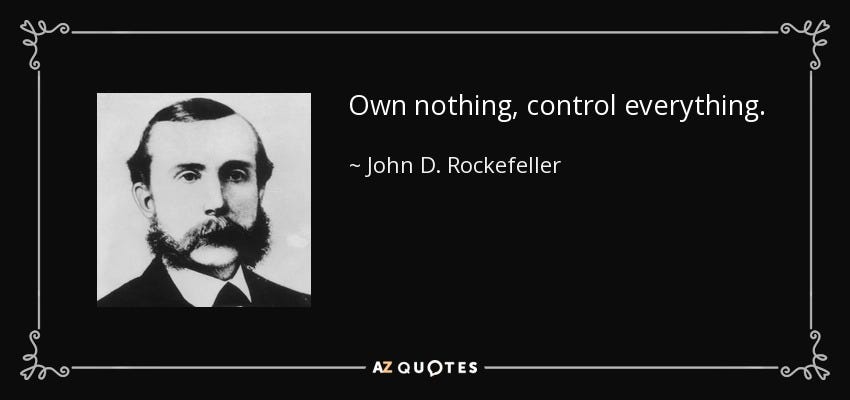
John D. Rockefeller used the example and teachings of his father to outcon the conmen. He utilized his vast wealth to influence schools, institutions, physicians, scientists, etc. The germ theory model of disease fit perfectly with his plans to sell his petrochemical poisons as “cure-alls.” He practiced the same snake oil principles to sell his elixirs to the public with mighty advertising dollars. To further these goals, in November of 1929, Rockefeller arranged a marriage and partnered with German pharmaceutical giant IG Farben (known as Bayer today) in order to control the pharmaceutical interests in the West. IG Farben was involved in war crimes during WW2 and was eventually dismantled into many companies after the war. However, this criminal involvement did not stop the Rockefeller’s, who went on to own over half the pharmaceutical interests in the US. To say that this venture was a lucrative undertaking for them is a huge understatement:
“In 1939 a “Drug Trust” alliance was formed by the Rockefeller empire and the German chemical company IG Farben (Bayer). After World War Two, IG Farben was dismantled but later emerged as separate corporations within the alliance. Well known companies included General Mills, Kellogg, Nestle, Bristol-Myers Squibb, Procter and Gamble, Roche and Hoechst (Sanofi-Aventis). The Rockefeller empire, in tandem with Chase Manhattan Bank (now JP Morgan Chase), owns over half of the pharmaceutical interests in the United States. It is the largest drug manufacturing combine in the world. Since WWII, the pharmaceutical industry has steadily netted increasing profits to become the world’s second largest manufacturing industry; [3], [4] after the arms industry.
The Rockefeller Foundation was originally set up in 1904 as the General Education Fund. The RF was later formed in 1910 and issued a charter in 1913 with the help of Rockefeller millions. Subsequently, the foundation placed it’s own “nominees” in federal health agencies and set the stage for the “reeducation” of the public. A compilation of magazine advertising reveals that as far back as 1948, larger American drug companies spent a total sum of $1,104,224,374 for advertising. Of this sum, Rockefeller-Morgan interests (which went entirely to Rockefeller after Morgan’s death) controlled about 80%. [5] See also AMA.”
https://www.sourcewatch.org/index.php/Rockefeller_Foundation
John D. Rockefeller, the great robber baron, had succeeded in achieving even greater success than his father could have ever dreamt of. After crushing his competition in the oil industry through ruthless practices, he had successfully maneuvered his business interests and he had taken control of the medical industry in the US in order to further profit from the petrochemicals created from his oil monopoly. By the 1920s, Rockefeller controlled the oil, chemical, and medical industries. He could sicken people with his product and then sell it back to them as a “cure” for whatever ails them. John had taken the con that his father was selling to small crowds and perpetrated it on a massive scale. He had achieved the great American fraud that is still being run to this day. John D. Rockefeller was the greatest snake oil salesmen of them all, most assuredly laughing behind the scenes about his concoctions magically being able to “cure” anyone willing to give him money, just as his father did before him.
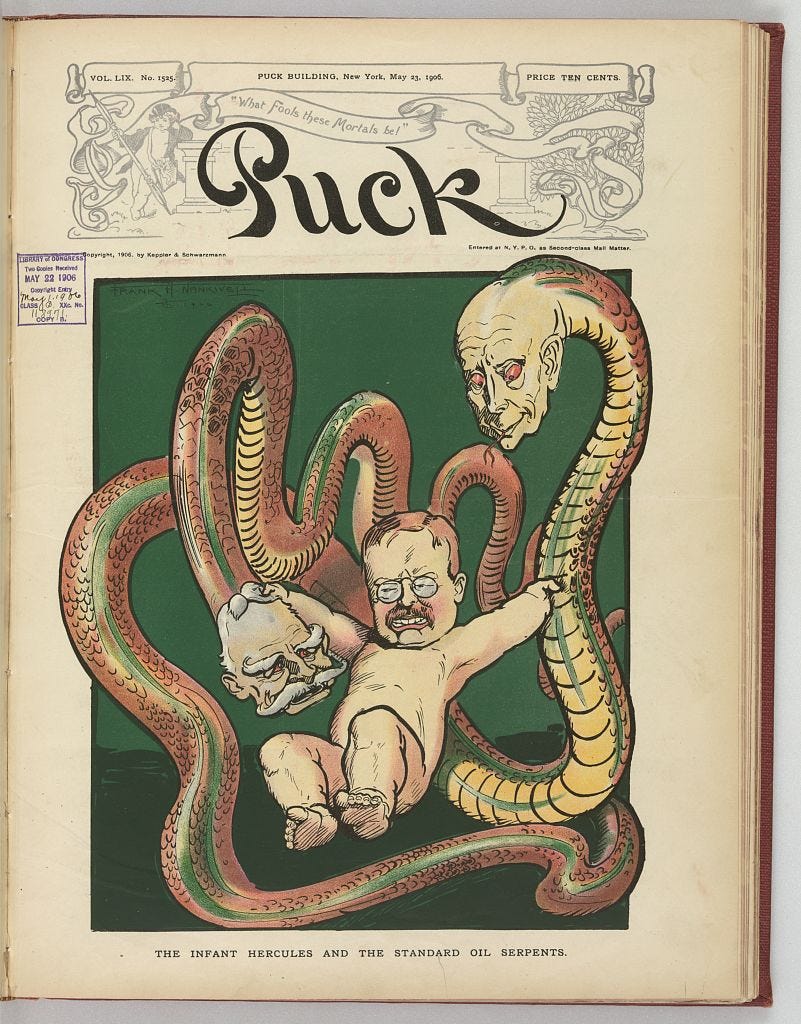
Dr. Johnathan Stea’s assessment that the snake oil salesmen of the past are still around today is an accurate one. However, it is not in the way that he intended it to be. The snake oil salesmen of today are not the wellness coaches (who don’t even sell products) or the holistic, homeopathic, and alternative medical practitioners who rely on the ancient healing traditions. The real snake oil salesmen are the ones tied to the allopathic medical system that was established by John D. Rockefeller. They are the ones now peddling his magical elixirs that are promised as “cures,” bolstered by millions in advertising campaigns. They are the ones selling opiates, chemotherapies, and synthetic toxins created from petrochemicals, keeping people addicted and dependent upon chemicals meant to suppress symptoms rather than cure disease. The only difference is that this practice, once demonized by the Rockefeller cartel in order to wipe away the competition, is now legitimized as “real medicine” once it was brought under their control in order to be profited from.
As a clinical psychologist, Dr. Stea should be looking at his own profession and the overreliance on ineffective and dangerous drugs meant as “cures” for mental disease. If he were intellectually honest enough to turn the spotlight onto his chosen career, Dr. Stea would realize that he, as well as the rest of his allopathic associates, are, in fact, the real snake oil salesmen.













